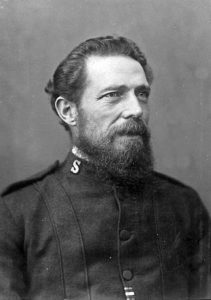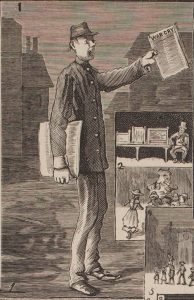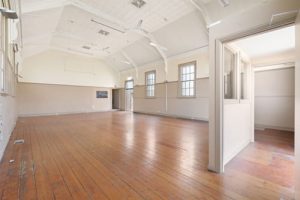The Salvation Army Hall at 9 Ross St is currently up for sale at a price believed to exceed $3 million Below is part of a talk that Max Solling gave to the Salvation Army on the Corps in its Hall on 13 September 1997.
The evangelical revival sweeping late Victorian Britain left its mark on Australia. The Salvation Army was born of this renewed fervour; its initial impulse was to save the unchurched slum dwellers of ‘Darkest England’. Charles Booth’s monumental investigation of London stretched over 20 years into housing and religious observance,, and attempted to analyse the degree of poverty that different occupational groups experienced from the 1890s. Few working class people set foot inside Anglican churches in inner Sydney a report of Sydney Anglican Synod found in 1900, resulting in Iocal missionary campaigns to reclaim the lives of the poor and dissolute.
William Booth (1829-I912), an apprentice pawn broker, resigned from the ministry of the Methodist New Connexion in 1861, and established the East London Revival Society in 1865, which after several changes became known in 1878 as the Salvation Army. Booth had married Catherine Mudford in 1855, a union that produced eight children. He preached the Gospel to the poor and underprivileged and by 1867 had developed a ministry offering basic schooling, reading rooms, penny banks, soup kitchens and relief aid to the destitute. This disciplined body, a direct response to the church’s neglect of the poor, offered a faith hostile to social pretension, and succeeded in mobilising the religiosity of labouring folk.
A uniform was gradually adopted by members. Full-time ordained ministers were known as Officers, and adopted military rank titles according to seniority. Part-time members were called Soldiers. William Booth became the Army’s General and the mission stations were called Corps.

The Salvation Army’s ministry in Australia began on 5 September 1880 when two immigrant English Salvationists, John Gore, a builder, and Edward Saunders, a railway worker, conducted their first meeting from the back of a greengrocer’s cart in Adelaide’s Botanic Park, and they appealed to Booth to send out an Officer. Captain Thomas and Adelaide Sutherland arrived in 1881. After Booth’s first emissaries arrived here the Army extended rapidly through the eastern colonies, establishing beachheads in working-class neighbourhoods in Sydney, Melbourne, Launceston, Hobart and Brisbane. And they gained strongholds in many working-class areas outside the capital cities, especially in mining towns. By 1888 Salvationist missionaries in horse-drawn caravans – ‘cavalry forts’ – were touring the towns in the far outback.
Tailor Tom Mudiman (1857-1943) was the first to ignite their brand of religious socialism in Sydney in 1882 when he declared war on the sins of the city, and the first Corps was founded here. Edward Saunders opened the Newtown Corps on 1 April 1883, another at Balmain (1883) and three Corps were founded at Forest Lodge, Paddington and Leichhardt, all in 1885. And the foundation stone was laid for its Congress Hall in Goulburn St in 1884.
The Salvation Army rented a building near the corner of St Johns Rd and Ross St for the Forest Lodge Corps, opened on 24 January 1885 with Captain Nellie Jaffray its Commanding Officer. In March 1904 the Corps moved to a Primitive Methodist chapel built in 1888 in Mitchell St and abandoned by them after a merger with the Wesleyans in 1902. Renamed Salvation Hall, it was the Corps’ meeting place until Scottish-born James Hay, Commissioner for Australia, opened their new hall at 9 Ross St Forest Lodge on 6 July 1911.
Primitive Methodism sprang from the pottery fields of Staffordshire, drawing its strength from labouring folk. Like the Salvationists, camp meetings and outdoor preaching were a feature of their religion together with brass bands. The ethos of social reform among the primitives fitted in well with the new Labor Party, and Primitive ministers strongly espoused Christian Socialism. Primitive chapels at Forest Lodge, Balmain and Leichhardt were located within a stone’s throw of Salvos barracks. Lay preacher at the Rehoboth chapel, Forest Lodge from 1874, Henry Carruthers (1846- 1936), claimed ‘hundreds of souls had been converted’ during its winter revivals.
The Salvos challenged the churches to try new ways as they sought to evangelise the working classes. Chairs replaced pews, they sang to a brass band not an organ, and preached from a platform not a pulpit. The Salvationists began their evangelical work as a protest against the prevailing religious orthodoxy. From the outset they adopted a theology, and mode of action which emphasised the individual’s guilt for sin and the dire necessity to ‘flee the wrath to come’.
The faith they offered was calculated to attract those who experienced the rough and harsh realities of working class life. To Army members a test of their own Christian profession lay in their willingness to render such physical and social assistance, without any necessary expectation of reward through conversion or affiliation.
As uniformed Army soldiers and Hallelujah Lasses marched along inner Sydney streets in the 1880s they were taunted and assaulted by groups of larrikins, highlighting the social chasm between the ‘rough’ and ‘respectable’ working class. The army used street processions to promote a religious code which condemned gambling, smoking, card-playing and alcohol. The opposition was sustained, demonstrating a deep-seated intolerance which brought the two groups into physical confrontation.

James Cummings (1849-1932), No 1 Soldier of the Forest Lodge Corps from 1885 to 1923 was a formidable opponent for harassing delinquents, with a strapping physique and strength, according to War Cry, which came from an early life of hard labour as a rural worker and miner. He remembered Iocal larrikins as reckless and sometimes brutal in their attempts to drive the Salvos back to their citadel. Larrikins, a sub-culture of single young men and their girlfriends, sought to break up their meetings –the street was a place where unrestrained masculinity often ran rampant. A constant attendant at meetings, Cummings also served as an Annandale alderman 1908 to 1922. On his death in 1932 ‘His spirit and life have worked to make the Corps’, War Cry wrote, ‘a little Heaven on Earth’.
By 1890 the Army had 99 meeting places in NSW, 25 of which were in Sydney, and at the 1891 census they claimed 10,315 members, 118 of whom lived in Glebe. The numerical strength of people claiming adherence to the Army altered little between the 1891 and 1933 census, just under 1% of the population. Though the Salvos sought to evangelise working people, during the severe economic conditions of the 1890s there was more emphasis on social work among the submerged tenth, those below the working classes who needed a bath, a bed and a bowl of soup. The Army sought to reach the poor through a variety of charitable agencies, extending from homes for fallen girls and dosshouses for vagrants to labour bureaus and disaster services. They opened a Rescue Home at Lyndhurst Glebe in 1893, but as accommodation was insufficient, they move to Newtown in 1895.
As Sydney’s inner suburbs became poorer, they were seen as natural locations for an extended philanthropy. Glebe’s reputation for social deprivation grew between 1890 and 1914 as other bodies sought to provide various forms of assistance for the poor – Sydney City Mission, remembered for their response to the physical needs of the indigent, St Vincent de Paul, the Dorcas Society, Glebe Benevolent Society and Glebe Local Distress Society.
Each Corps maintained a Soldiers Roll with names and addresses of members. Forest Lodge Roll lists reasons for removal. T for transfer to another corps, the most common reason. ‘B’ which stands for backsliding; ‘C’ is gone to Church or Chapel; ‘D’ is deserter of the colours, and ‘G’, in Army parlance, is ‘Gone to Glory’, the soldier had died. Each Corps also kept a History Book, a record of its activities.
Catherine Booth (1829-1890) grew into a courageous speaker, and played a major role in shaping the Army’s direction and doctrines. She was driven by a conviction that women had the same rights as men. Army regulations state one of its leading principles as ‘the right of women to an equal share with men’ in “its great work”. There were as many sisters as male Salvationists in the Forest Lodge Corps. English suffragette Ray Strachey (1887-1940) wrote in The Cause (1928) that chapel-based antislavery agitations were the first in which women’s right to an independent political voice had been acknowledged. The Salvation Army was the first national movement, religious or political, in which women appeared not as auxiliaries but as principals. Strachey argued that the Army ‘exerted a most tremendous influence upon the position of women’ and the ‘practical example of sex equality’.
The Forest Lodge History Book began in 1911. And with the Australian War Cry, the Army’s official news publication first produced in Sydney in 1883, these are the two main sources of Army Corps history. They yield rich insights at a local level into an array of activities and functions. The majority on the roll lived in Glebe; others came from the People’s Palace, Men’s Home, Young Women’s Hostel, Moore Park and Men’s Hostel, Albion St and Hammond’s Hotel, Buckland St.
Small traders could be found within the Army’s ranks, but the Salvos were less successful in attracting skilled workers. Arthur Arnott (1870-1941), son of biscuit maker William, joined the Forest Lodge Corps in 1893 where he was remembered as a violinist and concertina player, with a cheery demeanour and friend and saviour of drunkards. Colonel Arnott became one of the Army’s best known song writers, and the SAO biscuit launched by Arnotts in 1904, is thought to stand for Salvation Army Officer. In retirement Arnott was a self-appointed dance hall sergeant.
In 1900 the Corps held open-air meetings every Monday evening on the streets of Glebe where their martial uniforms and loud music were winning grudging respect from other Christians who gathered to watch. And Saturday night was when Ida Wilmott, a soldier since 1885, did the rounds of the Glebe pubs selling up to 75 copies of War Cry. Her funeral in July 1935 was a celebration by comrades of her 50 years of faithful soldiership. Sister Mrs Sherwood had been active since 1895 in the League of Mercy, regularly visiting Royal Prince Alfred Hospital and the sick and dying. ‘Mrs Sherwood often left her washtub to assist those in need’, and War Cry noted ‘once walked seven miles to visit someone in hospital’.
Since 1886 annual Self Denial appeals were a feature of Army fund raising, an opportunity for the community to give help to those in real need. The Corps collections in 1920 raised £140, and £180 in 1924, when for the first time officers received a full salary. Visits by the Petersham and Waterloo Corps bands were eagerly anticipated, and crowds in Ross St Hall spilled into the street in 1924 for the marriage of Violet Wilmott to Duncan Brown, with the wedding breakfast at Glebe Town Hall.
A highlight of the Young People’s Picnic was a chartered launch trip from Glebe Point to Nielsen Park in 1930, at a cost of two shillings for the return trip. Their Harvest Festival and the Anniversary tea party were attended by the Mayor of Glebe, The Nasturtium Fair was opened in 1931 by local chemist Orion Leggo (1894-1955) remembered for his entertaining speeches at Army functions, and for providing free medical advice for the poor and unemployed in the Depression. George Thorpe (1871-1948) joined the Forest Lodge Corps in 1913, and it was said, as Sergeant Major, was always at his post, never missed an open-air meeting for 35 years, an exemplary Salvationist; at his grave comrades paid tribute to a life of faithful devotion to the cause. Other families with long Corps associations were McCartney, Taylor, Sharp, Webb, Rochester, Turner, Vince, Moss, Harrison, O’Hara, Holley and Morris.
The Corps changed its name to the Glebe Corps on 7 November 1956. From 1968 Glebe became a Red Shield Counselling Centre, assisting 258 local needy families in that year. The District Head Office wanted to close the Corps down in 1971 because of a lack of officers. Open air meetings in 1973 encountered challenges from the Communist Party, the History Book recorded, and internal troubles within the Corps reached a climax in February 1973 with all planned meetings abandoned.
Closure of the corps was again mooted in 1975. Its doors remained open due entirely to activities of three comrades. Jessie Ford, Florrie Tomlin and Frank Price faithfully collected every week at the Trots, Dogs and at local pubs, and the money was paid in to District Headquarters. Grace Brothers, Broadway was also a favourite place for Army collections. Corps soldiers continued to come together on Sunday morning each week for singing, prayer and worship.

Jessie Ford (1908-1985) was Home League Secretary for Glebe from 1970 to 1985 when she died, a greatly respected person who travelled great distances to care for people. Florrie Tomlin (1921-1991) worked tirelessly for the Army and she too was generous in her support of those in their daily struggle. And Frank Price (1917-1985) was sworn in at Forest Lodge in 1938, for a time served at Newtown, and served as Colour Sergeant at Glebe from 1974 until he died on 6 August 1985. The Glebe Corps officially closed on 27 November 1991. After almost five years the Glebe Corps re-opened on 8 September 1996 with Lieutenant Lyn Edge, the Commanding Officer, who established an Army Cafe in Ross St.
The most visible part of the Salvos in Australia since 1880 are their uniforms and brass bands in addition to their great work in the community. It has a worldwide reputation for helping the poor and disaster victims but less appreciated is that it is a Christian denomination with its roots in many of the teachings of Methodism, and music and singing have always played an important part in its services.
Max Solling, Historian









One comment. Please add yours.
As a 82 year old retired Salvation Army Officer, I have been reviewing War Cry reports on Forest Lodge/Glebe Salvation Army Corps dating back to circa 1885. Finding Max Solling’s article on the Salvation Army Glebe has been very beneficial, His keen mind has provided me with Salvation Army history not readily available in its Sydney archives,
His reference to the Corps history book adds to my interest.